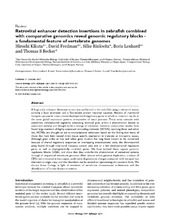| dc.description.abstract | A large-scale enhancer detection screen was performed in the zebrafish using a retroviral vector carrying a basal promoter and a fluorescent protein reporter cassette. Analysis of insertional hotspots uncovered areas around developmental regulatory genes in which an insertion results in the same global expression pattern, irrespective of exact position. These areas coincide with vertebrate chromosomal segments containing identical gene order; a phenomenon known as conserved synteny and thought to be a vestige of evolution. Genomic comparative studies have found large numbers of highly conserved noncoding elements (HCNEs) spanning these and other loci. HCNEs are thought to act as transcriptional enhancers based on the finding that many of those that have been tested direct tissue specific expression in transient or transgenic assays. Although gene order in hox and other gene clusters has long been known to be conserved because of shared regulatory sequences or overlapping transcriptional units, the chromosomal areas found through insertional hotspots contain only one or a few developmental regulatory genes as well as phylogenetically unrelated genes. We have termed these regions genomic regulatory blocks (GRBs), and show that they underlie the phenomenon of conserved synteny through all sequenced vertebrate genomes. After teleost whole genome duplication, a subset of GRBs were retained in two copies, underwent degenerative changes compared with tetrapod loci that exist as single copy, and that therefore can be viewed as representing the ancestral form. We discuss these findings in light of evolution of vertebrate chromosomal architecture and the identification of human disease mutations. | en_US |
